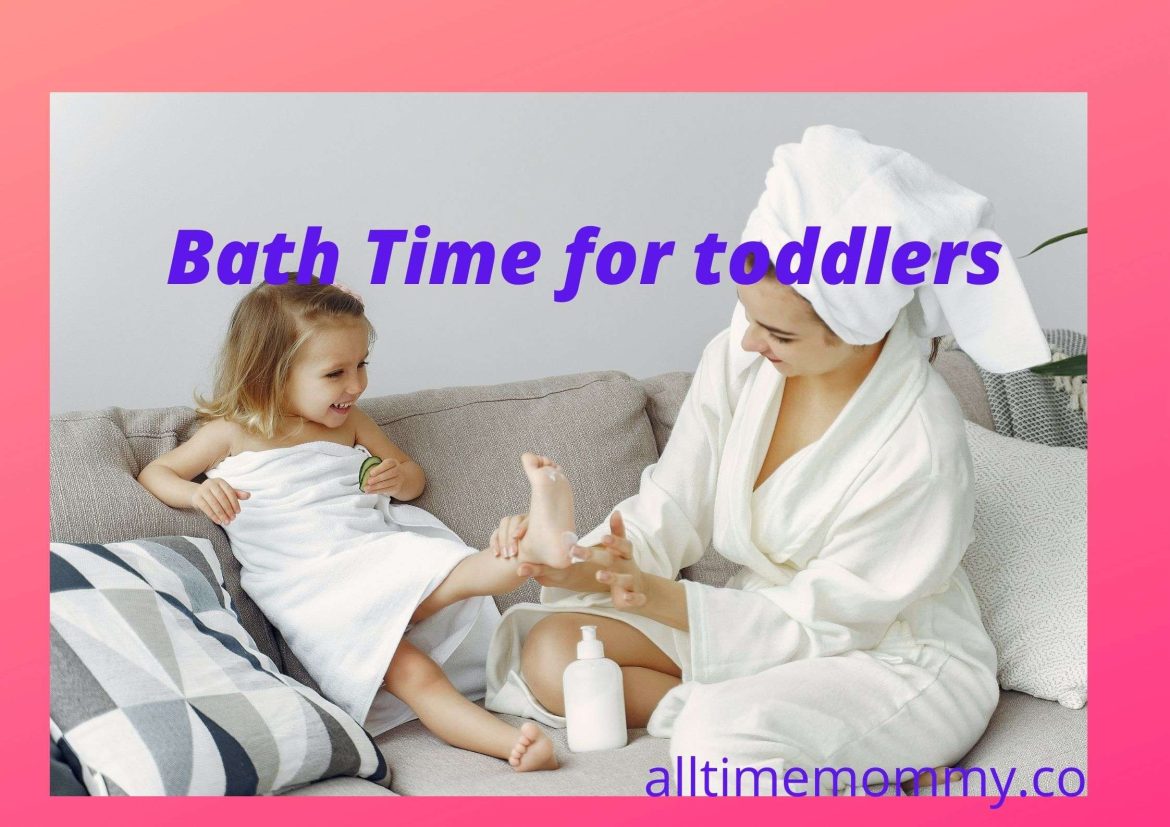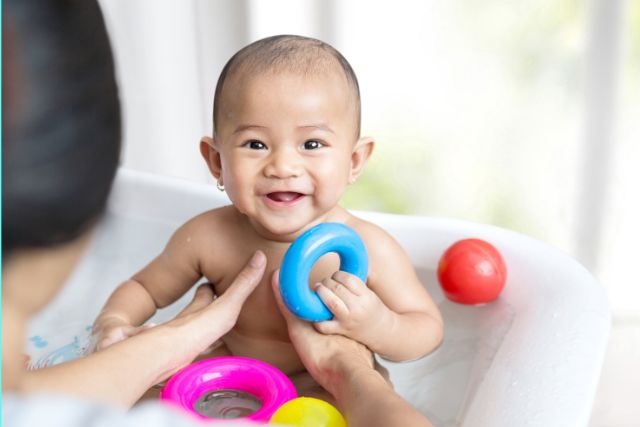Learn how to make bath time fun for toddlers with this easy tips.
Bath times are refreshing. They create bonding and learning moments for kids and parents.
Scientifically, bath times provide an excellent opportunity to enhance children’s cognitive and emotional skills.
For instance, please think of how your toddler feels when the water trickles down his skin.
You may also notice how they love bubbling the water. And, of course, the soothing scents of bathing soaps, not to mention the de-stress and relaxation they get for a better night’s sleep.
But, despite all these benefits, some toddlers still dislike bathing. Or, rather still too young to understand the benefits.
As a mom, you struggle to keep them in the tab, not to mention the screams and tantrums thrown around in opposition.
This article provides an overview of how you can make bath time fun and a great moment for anti-water toddlers.
But before we dive in, let us first examine the importance of bathing for mommy and baby.
Affiliate Disclosure: As an Amazon Associate, I get a small commission for purchases made from Amazon.com through links in this post. Learn more about our affiliate disclaimer here.
Importance of Bath Time for Baby and Mommy
Bonding time
Do you know that you can spend around 10 to 15 minutes per day bathing your children? Yes, this is quite a lot of time.
Unlike other times when you’re multitasking, bath time is a distractive-free moment. Hence you can use it to bond with your toddler.
Try catching up with their level of development by asking simple questions and noting their responses. You can also use the moment to find out their likes, fears, or dislikes.
Time to learn about body parts and their functions
Bath time can be a great moment to introduce sexuality lessons to kids without feeling guilty. Even though they still do not comprehend much at this age, we somehow know that Rome was not built in a day.
Start by mentioning parts of their body, one by one as you scrab. Let them know their private parts and why no one is allowed to touch them, especially in secret places.
You shouldn’t worry about doing this as a one-off lesson. Remember you have all the years to do it. Just begin, and when the proper time comes, your introductory lessons will save you, mama.
Teaching parts of the body during bath time forms a foundation for raising sexually street-smart kids.
Furthermore, I try to mention each body part with its functionality. And why it matters to eat a balanced diet so that these small body parts can grow healthy and stronger.
Self-Regulation
For preschoolers trying to get aligned in their daily routine, establishing a specific sequence of activities before bath time can give a sense of structure and control.
This is because routines create expectations. Knowing what to expect at whatever time can enhance their emotional regulation and behavioural skills.
Time for self-care lessons
Bath time is a great moment to teach your kid about personal hygiene. From washing the body to changing clothes, or even basic life lessons, toddlers and preschoolers can enhance their self-care skills through daily repetition of these activities.
Fine motor development
Bathing provides an all-around opportunity for your kid to engage. They touch, feel the water trickle down their skin, smell the soap fragrance, and even hear.
Sometimes they learn to distinguish water temperatures and hence can tell the difference between hot and cold.
These simple activities help to enhance their fine motor skills.
Time to play and relax
Children love playing with water, and there is no better time to do this than around bath time. I usually prefer to give my boy some time in the tub to enjoy himself with dripping toys.
Also, taking a bath offers some degree of relaxation, which helps kids to nap better.
How to Make Bath Time Fun for Toddlers
If you have an anti-water toddler or preschooler, try incorporating these tricks to see whether their love for bathing will pick up.
1. Incorporate bathing time in their daily routine list so that they anticipate it
Creating a specific time and familiar sequence of activities before bath time can help get your kid in the zone, hence lessening anxiety.
Let them see you mark the action as done in their daily routine checklist to motivate them as an accomplishment.
Also, be sure to get this digital bathroom shower for countdown excitement. A timer can serve as a transition signal making your toddler understand that it’s time to transition from playtime to bath time.
It also gives your toddler some sense of control over their bath time making it more interesting.
I mean,
Let them choose the duration of the timer (within reason) or allow them to turn it on and off. This can empower them and make them feel more involved in the process.
2. Find out and address their bathroom fears
Kids dread bath time for various reasons. Some hate it when water gets in their eyes. Others dislike their washing sponge or cloth.
Finding out what upsets your kid and consequently improving on it will result in a positive reception of bath time.
Be sure to get some exciting bathtime accessories for toddlers here.
3. Announce when you start the preparation
Suppose they are in the middle of a game. Informing your kid when bath time is nearing will prepare them psychologically and help them wind up peacefully.
What you may want to avoid is to stop them from watching their favourite cartoon in the name of bathing.
As an adult, you dislike interruptions. What makes you think that kids like it? Think of something that is constantly distracting when doing your favourite activity.
Will you tolerate it? Definitely no.
So to curb this issue of distraction, why don’t you get a helper like BATH TIME ALARM to help you announce the transition?
I promise your toddler will like it.
4. Allow them to participate in small bath activities
Involving your kid in bath preparation can get them interested in the activity. Allow them to help you set the bathing requirement.
Once in a while, you can allow your toddler to regulate the water temperature under your supervision. To spice up the job, have an exciting bath temperature toy or thermometer like these ones.
I mean,
These simple activities make them feel valuable and anticipatory for the subsequent sessions.
5. Be creative in the way you usher in bathing
Like my son and me, we hip-hop like frogs from the changing room to the bathroom. That way, it saves me a lot of heartache in dealing with tantrums as you drag someone to the tub.
Similarly, other moms prefer bathtime songs. Singing and dancing can be an excellent way to usher in bathing without drama.
6. Name the part of the body as you wash
You can even compose a song about body parts to drive the message. This not only makes bath time enjoyable but is also a way of learning. For example,” show me your left hand…this is my left hand”.
Doing this consistently may surprise you how easily your toddler can comprehend information. And may also increase corporation.
7. Turn bath time into a storytime
Telling stories when taking a bath can spike interest in your preschooler or toddler.
Tell them relevant stories in a fun and captivating way. For instance, you can explain why bathing is essential using animals as characters.
Of course, use a bit of exaggeration and draw your champ’s attention to why the gorilla bathes her kids twice a day. Come on, mama, unveil your creativity here. By the way, I used this trick to get my boy to like brushing his teeth.
8. Allow them time to play with water
You may introduce safe toys like these ones to make bath time enjoyable. Allow them to bathe their dolls, wash their cars or even blow some bubbles.
These activities distract them from your main agenda. And, creates a friendly bathing environment.
9. Color their water to make Bath Time Fun
You can break the monotony of bathing chronicles by this simple act. Use bath time colour tablets to tilt the bathwater.
Usually, you can do different colours for different days. Throw in some water shark toys to make it look like a sea. In case you don’t have the tablet, a few drops of food colour can save the day.
10. Motivate them with after bath cue
Figure out what they love doing and use it as a motivator. For instance, you may make it clear that he can only eat a cookie after a bath.
These cues entice them to perform the activity so that they can earn a reward. Be sure to use staff they are interested in as this will result in more cooperation.
Commandments to Childproof Your Bathroom and Prevent Injuries
- Never leave your kid alone or unsupervised in the bathroom, mama.
I’ve heard different versions of bathroom accidents, and some of them are heartbreaking.
Whether it is responding to a phone call or a doorbell leaving your toddler in the tub unsupervised can be dangerous. Always ensure that wherever you need is within reach, and you’ll not have to leave the bathroom until you’re done.
- Always ensure that your bathtub is empty when not in use.
- Have non-slip rugs or doormats on slippery floors to prevent slipping
- Always ensure that your water heater is adjusted and the water temperature is warm and not hot
- The bathwater should not exceed your toddler’s belly button when sitting
- Store your toiletry and cosmetics in lockable cabinets to regulate accessibility.
- Ensure that your bathroom door is locked when not in use.
- If you have electric appliances in the bathroom, like dryers, be sure to unplug them after use.
Common Questions
When are kids old enough to bathe alone?
6-7 years. Age six to seven is a great time to introduce some life lessons like self-bathing for kids.
Around this age, kids are curious to learn, plus they want to look useful around their space. Allowing them to do minor activities like self-bathing, and choosing what to wear or the type of snack to carry to school is a great way of validating their efforts.
My six-year-old boy expresses so much interest in the world around him. So I’ve always learned to seize the opportunity to introduce a new activity to his list.
Recently I introduced self-bathing, and we’re doing just fine. So for me, six years is good; however, you must exercise control and supervision to get things done correctly.
What is the right time for kids to take a bath?
If you’re doing it as a daily routine for better sleep, then 90 minutes before bedtime should be ideal. For example, if your kids are going to bed at 8.00 p.m.; bathing them at around 6.30 is okay.
This helps to warm up their body for increased blood flow, which is known to aid the natural circadian process. In the long run, they fall asleep quicker and for longer.
But, depending on your family values, you can still establish a bath time based on other activities to help establish a definite routine. For instance, taking a bath before or after dinner.
This way, your child gets to know when you expect him to take a bath or perform a similar activity on their to-do list.
How long should bath time last?
Children are prone to getting colds. So keep their bath time as short as possible. 8 to 10 minutes are okay, but it still depends on your bath time activity list. You should, thus, not forget that the sole responsibility of bathing is maintaining body hygiene.
With my three-year-old boy, there are days we take 10 minutes while others take more depending on songs and rhymes we have to recite ha! For my six years, I strictly count time for him because he can take as long as 30 minutes.
Takeaway
Bath times are crucial moments for parents and kids. You get to play, learn and strengthen your family bond. If you notice that your toddler dislikes taking baths, you can always incorporate creative ways to make it enjoyable.
Be flexible enough to accommodate your child’s needs, and don’t be afraid to give their body a water-free day once in a while. In all your decisions, always know that it all comes back to you as a caregiver and guardian.
That is my take. What do you think? Kindly leave a comment and don’t forget to share so that we can enlighten each other with simple parenting hacks.
Related:
- Bath Time Made Easy: How To Create a Calm and Stress Free Bath Time For Your Newborn
- 33 Things That Make Parenting Life Easier
- 9 Best Baby Soap and Shampoos (according to Dermatologists)



